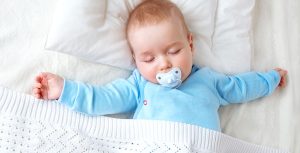
A pacifier – also called a dummy, soother, or binky – can be a soothing tool for babies. They are designed to soothe babies by imitating the sucking action they instinctively crave.
This action can help to calm and comfort babies, as well as help them to fall asleep. Pacifiers can also be a helpful tool for parents.
They can give parents a much-needed break and provide some peace of mind knowing that their baby is content and safe.
But once your baby is asleep, you may be wondering: Should I remove the pacifier?
It is a recurring question that many parents ask and is of great importance. After all, you want what is best for your child, and their safety always comes first.
That’s why Ask Her reached out to the specialists to get their professional opinions on the matter.
We will also look at the recommendations from The American Academy of Pediatrics (AAP). Keep reading to learn everything you need about pacifiers and baby sleep.

Many benefits come with using a pacifier for sleep. We know that sucking is a natural reflex for babies and can help calm and soothe them.
This is why pacifiers can be such a helpful tool, both for babies and parents. But the benefits of the pacifier during sleep do not end there.
Specialists say that several additional benefits come with using a pacifier for sleep.
One of the main benefits of sleeping with a pacifier is that it can help reduce the risk of ear infections.
Dr. Katrina Zhao, Principal Dentist at Midas Dental, explains this correlation:
— This is because they help keep the Eustachian tubes open, preventing fluid from building up in the ears.
The Eustachian tubes are responsible for draining fluid from the middle ear. When they become blocked, fluid can build up and lead to an ear infection.
Ear infections can be excruciating for babies and young children, and they can end up causing fever, fussiness, and difficulty sleeping.
So, if your child is prone to ear infections or you are looking for ways to prevent them, sleeping with a pacifier may be a good option.
Another significant benefit of using a pacifier for sleep is that it can help reduce the risk of Sudden Infant Death Syndrome (SIDS).
While the exact cause of SIDS is unknown, experts believe that it is linked to sleep. This is why many recommendations for preventing SIDS involve creating a safe sleep environment.
One of the ways that you can create a safe sleep environment is by using a pacifier. Studies have shown that babies who use a pacifier for sleep are at a lower risk of SIDS.
The AAP recommends that babies be given a pacifier at nap time and bedtime to reduce the risk of SIDS:
“Although the mechanism is yet unclear, studies have reported a protective effect of pacifiers on the incidence of SIDS. The protective effect of the pacifier is observed even if the pacifier falls out of the infant’s mouth.
A. The pacifier should be used when placing the infant for sleep. It does not need to be reinserted once the infant falls asleep. If the infant refuses the pacifier, he or she should not be forced to take it. In those cases, parents can try to offer the pacifier again when the infant is a little older.
B. Because of the risk of strangulation, pacifiers should not be hung around the infant’s neck. Pacifiers that attach to infant clothing should not be used with sleeping infants.
C. Objects, such as stuffed toys and other items that may present a suffocation or choking risk, should not be attached to pacifiers.
D. For breastfed infants, pacifier introduction should be delayed until breastfeeding is firmly established. Infants who are not being directly breastfed can begin pacifier use as soon as desired.
E. There is insufficient evidence that finger sucking is protective against SIDS.”
Sudden infant death syndrome (SIDS) is the sudden, unexplained death of a baby younger than 1-year-old. SIDS is sometimes known as crib death because it often occurs when a baby sleeps in a crib.
This syndrome is a leading cause of infant deaths in the United States.
Despite decades of research, scientists have not been able to identify a single cause of SIDS. However, they have identified several risk factors. These include:
Using a pacifier has been found to reduce the risk of SIDS. In fact, according to the AAP, “there is good evidence that infants who use pacifiers have a lower risk of SIDS.”
There are a few theories about how the pacifier may help reduce the risk of SIDS. One theory is that the pacifier helps keep babies in the supine (on their back) position.
This is the position that is safest for sleeping infants. Another theory is that the pacifier may help block airway receptors sensitive to carbon dioxide. These receptors have been linked to SIDS.
Whatever the mechanism, it’s clear that the pacifier can help reduce the risk of SIDS. This is just one more reason why the AAP recommends that parents offer their babies a pacifier at nap time and bedtime.
In addition to the physical benefits of using a pacifier, there are also emotional benefits.
For many babies, the act of sucking is soothing. This is true even when they are not hungry. If your baby is upset or stressed, sucking on a pacifier can help them feel better.
This can be extremely helpful for parents too. If your baby is fussy and you are trying to get them to sleep, a pacifier can help calm them down and make it easier for everyone to get some rest.
If your baby is having difficulty sleeping through the night, a pacifier can help.
Many parents worry about their baby’s sleep patterns. But it’s important to remember that every baby is different, and there is no “right” way for them to sleep.
Some babies will sleep through the night from an early age, while others may not start sleeping through the night until they are a bit older.
That said, there are some things that you can do to help your baby sleep better. One of these is to offer them a pacifier at bedtime.
As mentioned previously, the sucking motion of the pacifier can help soothe your baby and make them drowsy. This can help them fall asleep and stay asleep for an extended time.

While many benefits come with using a pacifier for sleep, there are also some risks. It’s essential to be aware of these risks so that you can make an informed decision about whether or not to use a pacifier for your child.
The main concern that parents have about pacifiers is the impact that they may have on their child’s teeth. And it’s true; some risks are associated with extended pacifier use.
Dr. Thomas McCarthy, who has over a 40-year long career in dentistry, warns:
— Overuse of a pacifier could cause misalignment issues. From these alignment issues, you can have an overbiteunderbite, crooked teeth, or spacing issues, among other issues.
Dr. Jas Sandhu supports this claim and adds:
— A baby’s first dentition occurs at around 5-6 months of age, and if your baby is sucking on a pacifier during this important stage, it may cause permanent changes to the alignment and shape of their teeth. Studies show that up to 44% of children who use pacifiers during their first six months of life develop malocclusion and misalignment of the teeth and mouth.
So, if you’re concerned about the impact pacifiers may have on your child’s teeth, you must talk to your dentist.
They will be able to give you specific advice based on your child’s individual situation.
A good rule of thumb is to wean your child off the pacifier as their teeth start to come in. This is usually around 6-12 months of age.
Another concern parents have about pacifiers is that their children may become dependent on them.
This means that your child may not be able to soothe themselves without the pacifier, and they may have difficulty sleeping without it.
Imagine this scenario:
Your child is crying, and you give them a pacifier to calm them down. They quieten immediately. This happens several times throughout the day and night.
Your child starts to associate the pacifier with feeling better and wants it all the time.
Before you know it, your child relies on the pacifier to soothe themselves. They may cry or become distressed if they can’t find it or if it falls out of their mouth (also during their sleep).
Jessica Daigle, MD, has shared with us some good practices when using a pacifier. They will help you avoid the dummy dependency:
Studies on this subject have conflicting results, yet we think that it is important to mention the possibility that sleeping with a pacifier may disturb breastfeeding. Using a pacifier might affect the length of time and how frequently you breastfeed.
However, Rachel Mitchel, who provides Pediatric Sleep Consulting at My Sweet Sleeper, has some advice on how to avoid that risk:
— Generally, my recommendation is to wait to introduce the pacifier once the breastfeeding relationship has been established (usually a minimum of one week) and hold off on introducing it if the child is having a hard time latching or extracting milk. Women can also work with a lactation specialist if needed to ensure there are no challenges with breastfeeding.
While research on the subject is still being conducted, it is worth having it in mind and maybe avoiding using the pacifier in the first few weeks/months if you are breastfeeding.

The American Academy of Pediatrics and the American Academy of Family Physicians recommend that children should be weaned from pacifiers in the second six months of life to prevent otitis media.
It is generally recommended that you start weaning your child off the pacifier as their teeth begin to come in. This is usually around 6-12 months of age. However, every child is different, and you should talk to your dentist for specific advice based on your child’s individual situation.
Prolonged use of pacifiers can lead to dental problems such as malocclusion (misalignment of the teeth), open bite, and disruption of the average growth and development of the jaws. And the longer you wait to wean your child off the pacifier, the harder it will be for them.